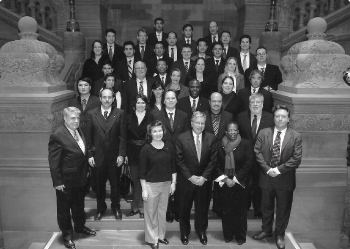
Economic Development


Albany Office
LOB 847
Albany, NY 12248
518-455-4767
With the state’s Empire Zones Program now scheduled to sunset in 2010, the future direction of New York’s economic development efforts was the subject of public hearings held by the Economic Development Committee this fall.
The 2009-2010 state budget embodied significant reform and change in the state’s Empire Zones Program. New more stringent tests for existing participants in the program were enacted and are being applied retroactively. Future participants must meet even higher standards. The sunset of the zones program was accelerated to June 30 of 2010. Businesses considering expansions and site selectors are unsure of the nature of state assistance going forward. Even surviving participants in the zones program are unsettled by the prospect of the state changing the rules in midstream again. While the economic development and business sector looks for certainty and reliable partnership with the state as business decisions on expansions or projects in the pipeline are being made, there is little but uncertainty on the horizon.
It may be an over-used metaphor but New York State does indeed find itself at a critical crossroads in economic development. We need to re-establish trust, undo the damage that has been done, and set the state on the economic development road of predictability and continuity. We can achieve that goal by quickly establishing a better program, and having it in place by early spring. Or, failing that, we can extend the Empire Zones Program as it is now reconstituted well into the future, beyond this June’s currently scheduled sunset date.

After hearing from a number of economic development professionals and business leaders, both at the hearings and over the course of the past year, it’s become clear to me that if the course is to transition to a new program, it should cover four bases.
First, it needs a globally competitive component that site selectors and in-state companies can know of and count on as an inducement for business attraction and expansion. It must be as robust as the current zones program’s “regionally significant project” component, which could simply be carried forward.
Second, distressed communities need special attention. Many of these communities have a particular type of zone—called “census tract” or “investment” zones. By building upon these zones and applying the 2009 standards, the state will be both returning the zones program to its original distressed community focus and tightening up the program.
Third, a new program should pay special attention to the needs of companies which generate the greatest economic benefit in importing dollars into a community by exporting goods and services out of the community, especially those companies which use local supply chains to acquire the ingredients of their exported goods or services. We simply cannot afford to lose any more of these “high value” enterprises—such as manufacturers.

Fourth, in an ever-changing world, a new program affords the opportunity to provide the missing link in the “innovation continuum” in New York State. While New York is home to countless creative innovators, and while we spend immense sums on research and development, we paradoxically provide disproportionately little assistance in early-stage seed capital funding. As a result, new start-ups either fail or leave the state before they reach the venture capital stage and may end up producing their cutting-edge products invented here elsewhere. Early-stage seed capital funding can bridge their “valley of death” and generate deal streams for venture capital investment here in New York.
A new program that covers all four of these bases would be a home run for New York. But to stay in the big leagues, it must be put in place quickly. Failing that, we may be better off to continue the current zones program as it is now reconstituted.
Sincerely,

Robin Schimminger Chair,
Committee on Economic Development
For too many years, small businesses were victimized by overreaching actions by state agencies which overzealously pursued their regulatory goals, sometimes beyond what the law allowed. Too many times, small businesses simply acquiesced since the costs of going to court and paying high legal fees outweighed the cost of compliance.
To address this problem, I authored New York’s Equal Access to Justice Act (EAJA) to allow small businesses, not-for-profit organizations and individuals of modest means to fight back in the face of state agency actions which lacked substantial justification and got it enacted into law in 1989. The EAJA authorizes an award of attorney’s fees and court costs to small businesses and other eligible litigants who have been wronged by the unjustified actions of New York State agencies and prevail when challenging those actions in court.
Over the years, I have monitored the value and importance of the law to determine whether changes or updates were required. Recent court decisions, beginning with a U.S. Supreme Court ruling in 2001 (Buckhannon v. West Virginia Dept. of Health and Human Services, 532 US 598), have effectively chipped away at the EAJA. As a result, New York courts no longer find these litigants to be the “prevailing party” entitled to attorney’s fees when the state agency simply settles prior to a final judgment, often in order to avoid paying the small business’s attorney fees and court costs under the equal access law. This now requires a change in the EAJA to preserve its ability to do what it was designed to do: give “the little guy” or “underdog” a more equal playing field when taking on state agencies that overstep their authority.
The court decisions impacted the use of EAJA in such a significant manner that for the 2007-2008 state fiscal year no attorney’s fees were paid by state agencies in these types of cases. As a result of this failure to award fees as contemplated by the equal access law, small businesses, non-profits and qualifying individuals are increasingly unwilling to use the equal access law to fight back. The effectiveness of the EAJA in tempering overarching state action is negated, and the ability of small businesses, not-for-profit groups and people of modest means to fight back by having their attorney fees and court costs covered is trumped by state agencies simply settling before a final judgement is reached.
I introduced legislation, A.7395/S.4534, to remedy this problem by amending New York State law to mirror provisions in the New York City Human Rights Law and a 2008 U.S. Senate bill to award attorney’s fees in actions where the pursuit of litigation has acted as a “catalyst for a voluntary or unilateral change in position by the opposing party (i.e. the government agencies) that provides any significant part of the relief sought.” This legislation will overcome the recent court decisions, which took the teeth out of the Equal Access to Justice Act, and re-establish it as an effective tool for small businesses and others faced with unwarranted bureaucratic overreach.
The Assembly approved A.7395 unanimously on May 6, 2009. The companion Senate bill, S.4534, was under review by the Senate Rules Committee when this report was printed.
The New York State Directory of Small Business Programs, a first-of-its-kind, comprehensive and interactive guide that will assist entrepreneurs in starting new businesses and will provide current small business owners with invaluable information and resources, was unveiled in September.
The handbook is a direct result of the work done by the Governor’s Small Business Task Force, a group of statewide business leaders that convened this summer. Governor Paterson charged the task force with developing new strategies to address the concerns of small business in New York and to promote their growth and development.

The directory will create a more open and helpful environment in which businesses can grow and prosper, providing business owners and entrepreneurs with information on financing, tax breaks, and dozens of other topics. It works as a clickable .pdf file with descriptions of 143 state programs from 28 agencies aimed at helping New Yorkers start and grow their businesses. These valuable resources for business planning and operations are organized into the following categories:
For example, users interested in starting their own business can click on the “Technical Assistance” tab to learn about the State’s Entrepreneurial Assistance Program, its Small Business Development Centers or Empire State Development’s (ESD) Statewide Regional Offices. Under “Funding Incentives,” the directory lists more than three dozen ways in which small businesses can apply for grants, loans, tax incentives, rebates on energy bills and other financing options. The directory is available at: www.ny.gov/governor/press/pdf/DirectoryofSmallBizPrograms_F_09-09.pdf and is also posted on www.nylovessmallbiz.com.
The directory also highlights State programs that assist in workforce recruitment and training and gives a detailed description of how prospective business owners can comply with New York State permit and licensing requirements.
Functioning as a mini website with active Internet links to every listing, the directory can be saved to your computer or organization’s website for easy access for your employees, members or customers, or it can be printed and used as a booklet.
The $120 million Upstate Regional Blueprint Fund and the $35 million Downstate Revitalization Fund were created in last year’s state budget to assist communities with the resources needed to attract development, improve commerce, create jobs and revitalize local economies. This fall, the Governor announced the first round of projects that were funded from these two distinct Funds.
A total of $17.5 million was awarded to 15 projects to revitalize New York’s Upstate economy, including $4 million to redevelop the historic DeWitt Clinton Hotel in Albany, $1.5 million for the Fulton Thermal Corporation factory expansion in Central New York, $1.7 million for Richardson Brands Company’s expansion in the Mohawk Valley, and $2.4 million for further development of the Buffalo Lakeside Commerce Park. The $7.8 million in Downstate awards included $650,000 for the Calverton rail spur extension on Long Island, $1 million for a green manufacturing center at the Brooklyn Navy Yard and $800,000 for the Brooklyn Brewery expansion.
Both Funds invest in projects that advance local development and small businesses, including making improvements to industrial parks and providing loans for the purchase of equipment, real estate or other needs. Eligible applicants include municipalities, businesses, academic institutions and non-profits, and awards range from $100,000 to $5 million. The programs give a preference to requests for loans, with principal repayments able to be recycled for future projects.
To ensure that each project meets the needs of its region, all applications undergo a competitive review process by Empire State Development’s regional offices. Requests for business assistance are reviewed on a rolling basis, with requests for infrastructure and downtown redevelopment assistance considered on a quarterly basis. Further information is available through ESD’s regional offices.
Seed-stage Investments. Would create the Small Business Technology Seed Investment Program to provide investment in start-up ventures. A.1111-A, Passed Assembly
“One-stop” Small Business Centers. Authorizes the Department of Economic Development to establish regional “one-stop” centers for small and medium-sized businesses to access business assistance programs and seek assistance in compliance with regulations. A.2201-A, Chapter 352
Low-Interest Loans. Makes businesses located in federally designated empowerment zones, enterprise communities or renewal communities eligible for the lowest interest rate available for bank loans through the Linked Deposit Program. A.2819, Chapter 424

Telephone Service. Would offer small businesses the option of paying for telephone installation, service initiation and non-recurring maintenance charges in installments. A.2928, Passed Assembly
Strategic Training Alliance. Would create a framework for the state to provide skills training services to businesses through networks of employers within a region. A.2849, Veto #47
Manufacturing Assistance. Would coordinate the delivery of economic development services by several state agencies to clusters of manufacturing industries and their supplier networks. A.2852, Passed Assembly
Private Sector Review. Would establish a Private Industry Review Council to evaluate and make recommendations for improving the performance of state economic development financial and business assistance programs. A.2854, Veto #32
Bank Export Incentive Program. Would permit the Job Development Authority to place monies with participating banking organizations that, in turn, invest the funds and lend an amount equal to two times the funds provided them to eligible businesses for export sales. A.4881, Passed Assembly
Self-Employment Assistance Program. Extends the Self-Employment Assistance Program, which allows individuals receiving unemployment insurance benefits to participate in entrepreneurial training to assist them in starting a small business, until December 7, 2011. A.6050, Chapter 106
Academic Research Information Access Act. Would allow for the shared access of research publications and other information resources by academicians and researchers in the fields of science, technology, engineering and medical research. A.7229, Veto #80
Equal Access to Justice Act. Would strengthen the law that allows small businesses to recover legal fees and expenses when successfully challenging unjustified state agency actions. A.7395, Passed Assembly
Notice of Proposed Rulemaking. Would improve the rulemaking process by providing a clear mechanism for the public to request and receive an extension period of the comment period on a proposed rule. A.7458, Veto #9
New York Main Street Program. Codifies and expands the New York Main Street Program that helps improve downtown and neighborhood commercial areas by providing funds for streetscape improvement, façade renovation and building rehabilitation. A.7967-A, Chapter 389
Commercial Production. Clarifies the measuring standards applicable to the “growth credit” available to qualified production companies as part of the Empire State Commercial Production Credit and clarifies that various production techniques shall qualify as production costs. A.8018-A, Chapter 448
Disabled Veteran Business Opportunities. Would improve the opportunity for service-disabled veterans who are owners of small businesses to participate in the government procurement process and sell goods or services to the state and/or local governments. A.8555-A, Veto #76
Energy Conservation. Makes energy conservation and efficiency projects related to improving the energy efficiency of buildings, manufacturing or industrial systems eligible for financial assistance through the Urban Development Corporation. A.8643, Chapter 406
Aircraft Repairs. Repeals the December 6, 2009, sunset of the current sales tax exemption for the maintenance, repair, overhaul or rebuilding of an aircraft, making the exemption permanent. A.8891, Chapter 204
Green Jobs, Green New York Act. Provides for energy audits and energy-efficient retrofits for small businesses and “green jobs” training initiatives among various other provisions. A.8901, Chapter 487 & A.9031, Chapter 488
Historic Property Tax Credit. Revises the commercial credit available under the state’s Tax Credit for Rehabilitation of Historic Properties by limiting its availability to distressed areas, increasing the percentage of qualified rehabilitation costs that can be claimed, and increasing the cap on credit value. A.9023, Chapter 239
Low-Cost Power. Extends the Power for Jobs and Energy Cost Savings Benefit Programs through May 15, 2010. A.9039, Chapter 217